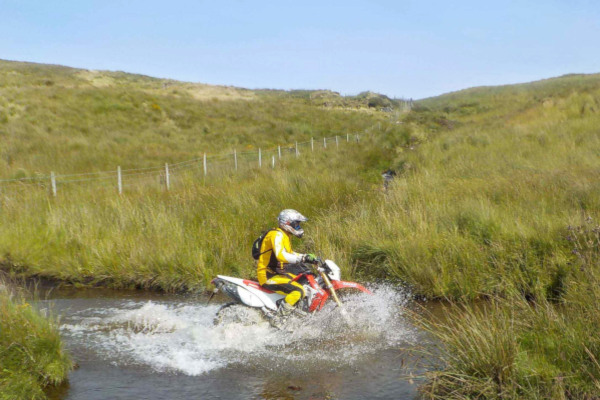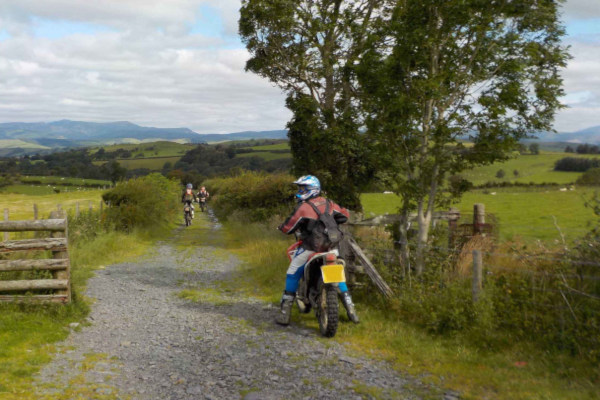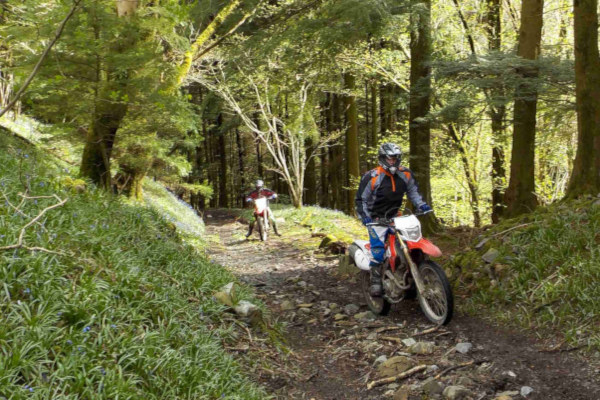Care of the hire bike
Please ride through water slowly sitting down - too fast and water gets into the electrics and even into the combustion chamber which can cause an engine to blow up. If you are unlucky enough to fall off in water, and the air filter has gone under, do not try to start the bike until it has been dried out, as you can cause irreparable engine damage.
Please do not sit with the engine running and the clutch in - it will start to drag. If you get stuck on a hill and can't get any grip, please don't keep trying: get off and wait for assistance. (The clutch could burn out – we have had one go in less than 5 minutes!)
Please don't alter the tyre pressures on the bikes. They are set correctly for the tyres and terrain we use.

After falls
Please don't pick the bike up by the rear mudguard as it breaks. Pull the lower handlebar as far forward as possible (front wheel pointing up in the air) and lift with both hands on the lower grip. Check throttle action is not damaged, and have a look for oil leaks on the casing beside the gear lever, and coolant leaks.
If the bars are not straight, it is unlikely they are bent; it is easy to straighten them, so please ask. If a lever is broken, we will usually have a spare and can replace the broken one. If your brakes seem to be getting spongy or the travel is increasing, please mention it. The disc brakes can suffer from hydraulic fluid leakage if the master cylinder takes a knock and the junction nut loosens.
Be careful to ride with your foot out slightly (except in deep ruts) to avoid keeping the rear brake on or depressing the sidestand by mistake. We accept that minor damage will occur to the bikes, especially if it is your first time trail riding. Please do not be afraid to tell us if you think something is not quite right. Very often it can be sorted out quickly and simply.

How we ride
Riding positionMost of the time, you will get less tired and make better choices if you are standing up. Stand with feet level or heel slightly down, middle of the peg, legs straight but not locked, angled slightly back so that you lean forward at the hips. Keep your legs in touch with the frame or tank, as that stablises the bike. If you find yourself pulling on the bars, make sure you are not crouching or bending your knees, as that has the effect of throwing your upper body back which upsets your balance. Look well ahead, and do not follow another rider too closely, as he will block your view of what is coming up. Many riders cover the clutch and front brake with one or two fingers.
WaterWater is risky! Water in the engine is to be avoided at all costs! If you are riding through puddles or streams more than about 6" deep, we advise sitting down so you have a chance of getting a foot down.

Hills up
Attack with momentum and confidence in a gear which you think will get you to the top (usually third or second). Cover the clutch with one or two fingers and if the revs are dropping but you are nearly there, slip the clutch. Avoid changing gear on the hill.
Look well ahead. If the hill is very steep and the surface is loose or slippery, you may not be able to brake much. Start from a standstill or walking pace. Use two fingers on the front brake and a light touch on the rear. As you become more experienced, you will develop a feel for the grip the front is giving you, and will learn to brake as much as is possible, releasing pressure just before losing grip. It is the front which will stop you, although extra pressure on the rear can be useful if there is a hairpin bend, as you can slide the back round. The slowest you can go is first gear with the clutch out (which can be surprisingly fast!) Never pull the clutch in going downhill – you will go faster, and you have less (no) control!

Ruts
Ruts do not look difficult, but are the feature which cause the most trouble. Look ahead, keep the power gently on with lowish revs/higher gear, and ride smoothly without sudden acceleration or slowing down. If you have to brake, be as gentle as possible. Narrow ruts in the centre of a track caused by motorcycles are often impossible to ride standing up, whereas Landrover or tractor ruts can become easy to ride if they are wide. If the rut is deep, make sure you feet are not vulnerable to being pushed off the peg – it hurts! Really deep or very slippery ruts may need to be ridden sitting down with feet out frontwards or paddling.
Do not try to get out of a rut – you never can unless you are some sort of trials or enduro God!
If it is possible, pull the handlebar which is lowest to the ground, as far forward as you can. The front wheel will be pointing upwards. Then pick up from the lowest handlebar. This gives more leverage, and makes it easier. Do not grab the mudguards or any plastic parts, as it is likely you will break them.
Doing the gatesIf the ground is uneven or down hill, it is best to stop the engine leaving the bike in gear, as it is less likely to roll off the stand and fall over. You can use the kill switch to stop the engine.
